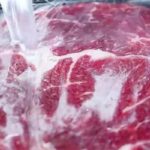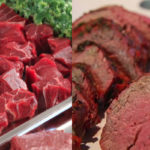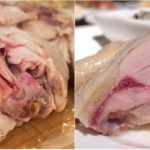Defrosting meat for later consumption is a common practice for most people, regardless of their culinary enthusiasm. To prepare frozen meat, you must thaw it. However, if you notice a reddish liquid oozing from the meat after thawing, you might have done it incorrectly.
Is the Red Liquid Oozing From Thawed Meat Blood?

This is undoubtedly a concern for many. And if you’ve always thought that the reddish liquid is blood, then you’re mistaken!
The red liquid oozing from thawed meat is not blood but Myoglobin, a type of protein that supplies oxygen to the muscles of animals.
This protein turns red when the meat is cut or exposed to air. When heated, the protein will turn darker and more brownish.
Jeffrey Savell, a Meat Science Professor at Texas A&M University, shared with HuffingtonPost: “Meat is about 70% water. So, if there’s water coming out of the meat, it’s water, myoglobin, and other pigments leaking out. I can assure you it’s definitely not blood.”
Additionally, according to the Lawrie’s Meat Science cookbook, red meat cooked to an internal temperature of around 140 degrees F (about 60 degrees C) will have a pale pink interior. If the temperature rises to between 140 and 158 degrees F (60 to 70 degrees C), the meat will be pink. Higher temperatures will turn the meat grayish-brown.
If your defrosted meat is leaking red water, it has lost a significant amount of protein.
What Types of Meat Contain Myoglobin?
Most red-meat animals contain Myoglobin. Since they rely on their muscles for various activities, they have higher Myoglobin levels.

As for poultry, such as chicken, duck, and goose, they have both white and dark meat. The redder meat is usually found in the legs and wings, which are the more active parts of these birds.
Most fish have white meat. However, some species like tuna have darker meat.
Should You Discard or Cook the Red Liquid From Thawed Meat?
This is another common concern after learning that the liquid oozing from thawed meat is not blood. However, most people share the same view: it’s best to discard this liquid as it can make your dish slightly fishy-smelling (due to iron) and less tasty.


How to Defrost Meat Without Losing Quality?
It’s simple: take the meat out of the freezer about 12 hours before cooking, wrap it in a thin cloth or plastic wrap, and place it in the fridge overnight. This way, the meat will be properly defrosted without losing its nutrients.

With this information and suggestions, we hope you’ll be able to defrost your meat without losing its nutrients from now on!
Is the Red Liquid Oozing Out of My Steak Blood?
Steak au poivre is a French culinary masterpiece, a dish that tantalizes the taste buds with its unique combination of seared beef, a hint of frying, and a symphony of spices including oil, fat, and the subtle sweetness of onions. However, a question that often arises when indulging in this delicacy is whether the red liquid that escapes from the meat is blood. Join us as we demystify this culinary conundrum and explore the true nature of this savory essence.



































